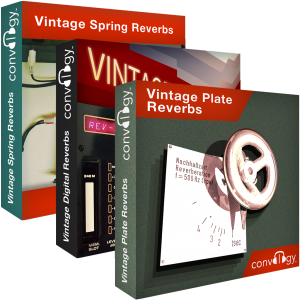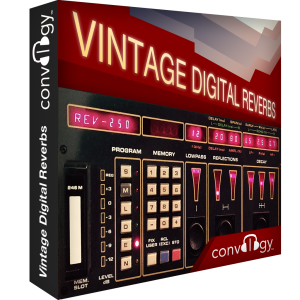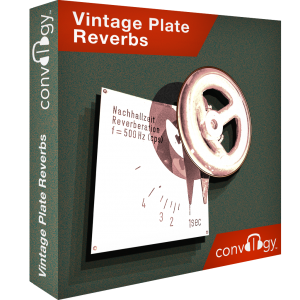Category Archives: Studio One
A Cubase User, a Logic User, and a Digital Performer user Find Common Ground in Studio One
[We recently came across a great story—three different producers, all of whom use different DAWs, needed to collaborate on a single project. They decided that Studio One offered them the best of all three worlds, and chose it for their collaborative effort. Details below courtesy of Roger Hooper, Robert Holmes, and George Napier.]

George Napier’s Studio
George Napier kicks things off by describing the task at hand, as well as the backgrounds of the collaborators.
“Robert, Roger, and I took a group of 11 executives from a 75-person tech startup into Studio A of Omega Studios for two days of team building. We needed to prepare backing tracks and beds for them to play against. Roger is a film composer, former Logic guy and current Mac-based Cubase user. Robert is a musician and games music composer and a 20 year die hard Digital Performer user who switched to Windows on DP and was not liking the experience,” says George. “I’m a composer/sound designer and a bit of a serial monogamist when it comes to DAWs. I’ve used Studio One since version 1, left it for Logic/Cubase at 2.6, and came back to try it out with the release of 3 (all on Mac). FYI: We all work together on projects for each other’s companies. This particular project was done under Robert’s company ResonantClarity.
Roger Hooper is a longtime Cubase and Logic user who was new to Studio One for this collaboration. His impressions and description of the collaborative workflow follow.
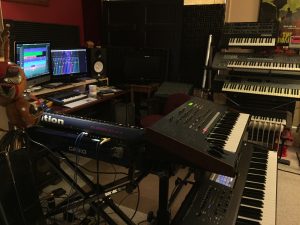
Roger Hooper’s Studio
Robert Holmes is a long-time Digital Performer user who made the switch to Studio One after a 20-year commitment to DP. He’s a self-proclaimed “old pop/rock studio guy from LA who ended up doing game scores in the golden age of adventure games.”

Robert Holmes’ Studio
“I had one interesting experience where I was mixing, and I was getting lots of crosstalk,” recalls Holmes. “And it was actually very cool from a sonic point of view, but it was making mixing a challenge. That’s when I discovered the Console Shaper had accidentally been activated on the master track somehow and was in Crosstalk mode. So YES, the crosstalk really works if you want that Gold Star Studio Wall of Sound.”Despite a lengthy relationship with Digital Performer, Holmes has taken the plunge and made the switch to Studio One as a result of his experiences in this project.
“I never looked back.”
Buy a StudioLive CS18AI, get Studio One Professional
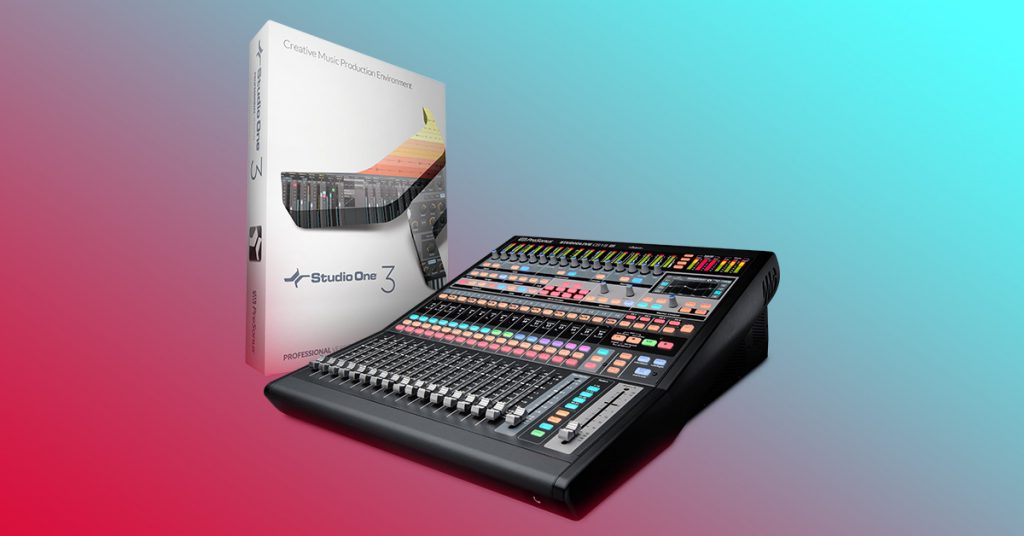
Get Studio One 3 Professional when you buy a StudioLive CS18AI
There’s no rebate forms or any of that mess—just register your CS18AI at my.presonus.com and Studio One Professional will be available in your my.presonus.com account for download!
Equipped with 100 mm, touch-sensitive, widely popular motorized faders and AVB networking, the StudioLive CS18AI control surface provides a compact, intuitive mixing solution for PreSonus StudioLive RM16AI and RM32AI rack-mount digital mixers and Studio One 3. The CS18AI connects to your network with a CAT5e or CAT6 Ethernet cable, eliminating the need for cumbersome analog or digital snakes and stage boxes, and offers a host of other useful features. It adds up to a powerful mix control system with a fast, intuitive workflow and the latest networking technology.
“Our StudioLive Active Integration mixing systems are the only solutions that allow you to customize your mixing experience to fit your individual needs. With a StudioLive RM as the mix core, you can choose to work with physical motorized faders, portable wireless iPad, a large Windows 8 touch screen, or a combination of them all.”
—Ray Tantzen, PreSonus Senior Product Manager
Take a detailed look at the CS18AI with Rick Naqvi here!
James F. Reynolds on Studio One
[This just in from James F. Reynolds, pop and dance music’s “secret weapon.” He has mixed and produced a wide range of acts including Ellie Goulding, Emeli Sande, Years and Years, Tinie Tempah, and The Saturdays. Last year he made the switch to Studio One and was kind enough to share his insights with us.]
• For what applications are you using Studio One Pro? (Example: for recording, composing, sound design, and so on; in a commercial studio, project studio, for live recording, etc.)
I use Studio One 3 Professional for mixing, production, and recording.
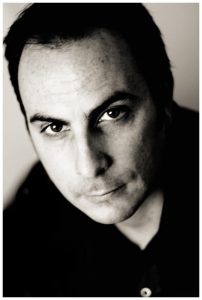
James F. Reynolds
• What led you to choose Studio One? Was it the company’s reputation, audio quality, ease of use, specific features, price, other factors?
I spent many years using a combination of Logic, Pro Tools, and Ableton Live, as they all have strengths in different areas. I had been searching for a while for a DAW that has the best of all these platforms, for example:
- The creative speed of Ableton
- The accuracy and mixing ability of Pro Tools
- The lay out and ease of use of Logic.
Last year I had quite a few producers in my studio talking about Studio One and decided to investigate further. After taking some time to get to know the program, it became apparent that this was a program that has been thought out really well and ticks the box of being a one stop shop for mixing/production and writing.
• Having used Studio One, what do you like most about it?
I have used it consistently for 5 months now and it has sped up my mixing and overall workflow. One of the best features is being able to set up a series of commands using Macros. It’s also very stable.
• What Studio One features have proven particularly useful and why?
The arranger track is very handy, as often when I am mixing a song, the label wants extended versions. The Arranger and also to try out different structures within the arrangement. This is very easy to do using the arranger as it can copy any section with all the automation related to it.
• Any user tips or tricks or interesting stories based on your experience with Studio One?
My tip is this: if you are trying Studio One out, stick with it. It’s always very difficult switching from a platform that you use day in day out for many years as everything is second nature. It takes a while to get back to this speed on a new platform but if you persevere it pays off !
• Please give me some basic background info on your career and current projects, credits, and so on.
I am mainly known as a mixer. I am currently mixing Emeli Sande and before that was mixing Ellie Goulding “Still falling for you” (U.S.A radio mix) and Kelly Clarkson. I also mix for a K Pop band called B.T.S who’s album last year broke records. I co wrote “Drinking from the bottle” with Mark Knight and Calvin Harris and Tinie Tempah. For more info, check out www.jamesfreynoldsmixing.com
• Any final comments about PreSonus and Studio One?
I am really excited about the future of Studio One and have been really encouraged by a development team that actually take on board feedback from mixers and producers and often implement ideas if they are good. This was a big frustration with other DAWs, as feedback was not listened to or acted on.
The Studio 192, Eris E44 MTM monitors, Studio One and Thou
Baton Rouge-based Thou—winners of Pitchfork’s Metal Record of the Year in 2014—recently took a Studio 192 on the road to record rehearsal sessions and demos for a forthcoming full-length.
Opportunities for collaborative songwriting had become more difficult for the band, as their members have scattered across the country. They typically only get together for tours and shows, making songwriting and recording opportunities somewhat scarce.
Not anymore. Recording straight into Studio One via the Studio 192 allowed the band to write and record in whatever impromptu spaces their tour found them in. Josh Nee (Drums) took recordings home to edit and mix demos for the record after returning from their most recent tour. The full-length, Magus, is on its way.
Learn more:
Linzey Rae, Studio One and a Crab Costume Walk into a Kitchen…
Many PreSonus customers ask, “what’s the deal with the Cajun recipes in the back of PreSonus manuals?” May seem odd coming from an audio company, agreed. The truth is, we think it’s cool. We’re a Louisiana company and we’re proud of it. Good food and good music go hand in hand, especially in Louisiana.
We thought it would be fun to combine those things so we hooked up our friend and PreSonus artist Linzey Rae from the band The Anchor with a classic Louisiana recipe for gumbo for one of her Metal Kitchen episodes. Bon Appetit!
She pronounced “andouille sausage” correctly and that makes all of us happy. Can’t wait to hear what’s next from Linzey and The Anchor! Thank you for sharing and for using Studio One!
Subscribe to Linzey’s YouTube page HERE and follow along on all their musical ventures HERE!
Try out Studio One for free HERE!
VocALign Project 3 now Available for Studio One 3 at shop.presonus.com
Now available at shop.presonus.com: VocALign Project 3!
 VocALign Project 3 provides the latest version of the basic and legendary VocALign program that has been available since 1995, providing instant tight alignment of one audio signal to another. Simply capture a Guide signal with the right timing, capture a Dub signal to be aligned, press one button, and a new aligned Dub is generated and returned to your DAW.
VocALign Project 3 provides the latest version of the basic and legendary VocALign program that has been available since 1995, providing instant tight alignment of one audio signal to another. Simply capture a Guide signal with the right timing, capture a Dub signal to be aligned, press one button, and a new aligned Dub is generated and returned to your DAW.
Quietly legendary, VocALign’s early life included use in music production ranging from Shania Twain and Steely Dan to Black Eyed Peas; as well as in popular TV shows such as Friends and Seinfeld and in blockbuster films including Harry Potter and Lord of the Rings.
Click here to buy VocALign at shop.presonus.com
- ARA (Audio Random Access) is a pioneering extension for audio plug-in interfaces. Co-developed by Celemony and PreSonus, ARA technology enhances the communication between plug-in and DAW, and gives the plug-in and host instant access to the audio data.
- Synchro Arts and PreSonus have worked together to integrate VocALign tightly into Studio One with a simple, streamlined workflow to provide automatic, instantaneous time alignment of the selected audio signals.
Editors can save hours in the studio and let VocALign do the fine re-timing work automatically. Users simply select Guide and Dub audio events and drag and drop them into VocALign which instantly edits the Dub audio to match the timing of the Guide.
- Compatible with Studio One 3 Professional v3.3.1 or higher
- VocALign Project takes just seconds to automatically align two audio signals so that the timing of one matches the other
- Simple, intuitive operation
- Sophisticated pattern matching techniques
- Rejects guide track noise
- Work with different speakers, singers, words, instruments, and sounds
- The aligned audio can be auditioned within VocALign Project
- Scrolling, scalable display allows instant visual confirmation of sync
- User interface allows adjustment of selected audio regions for processing
- User-adjustable processing presets ensure optimal performance
- Pitch of aligned audio is unchanged
- Pace iLok account required when used in Studio One.
Chocolate Audio Pianos for Studio One
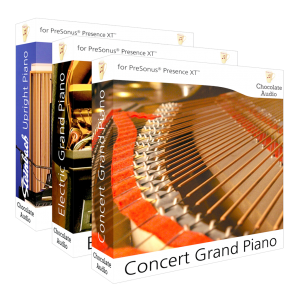
Looking for some of the best-sounding pianos you can get for Studio One? Look no further than this Piano Collection from Chocolate Audio. Three different pianos are available, each recorded with high-quality mics and expensive preamps. They also take advantage of Presence XT’s advanced scripting functionality to simulate the behavior of these beloved instruments as accurately as digitally possible.
If you’re not sure which piano is right for you and your music, check out the descriptions below. And if you’re still not sure after reading, get the combo pack of all three. The Chocolate Audio Piano Collection for Studio One is available only at shop.presonus.com.
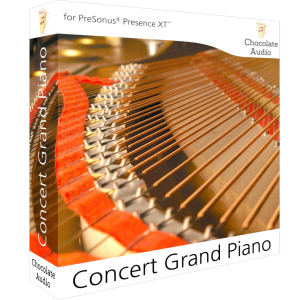 The Concert Grand:
The Concert Grand:
A recreation of a world-class concert grand piano sound as found in a Steinway D274 grand coda. This piano is gorgeous and rich in sound with a very well-balanced tone, very well fit for classical but equally at home with jazz and any scenario where a full piano sound is called for.
Great attention was paid to recreate this huge concert’s signature full and balanced sound through sampling. The sample set features 11 dynamic layers and a sustain pedal resonances layer, 12 release sample layers and pedal and key release noise effects tuned to perfection using Presence custom scripting. Studio One Professional users can load the multi-instrument preset which combines the two microphone sets for an even fuller control on its sound.
The Concert Grand offers two different phase-coherent recording setups: a player’s perspective recorded with Schoeps CMC6 microphones and a listener’s perspective recorded right at the edge of the lid with Neumann KM microphones, all matched-pairs going through Millennia preamps.
Electric Grand: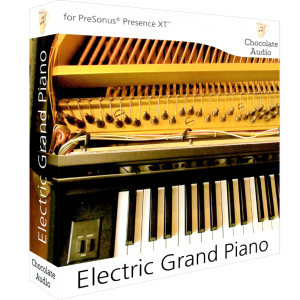
A top-notch rendition of a famous Japanese electric grand piano. At that time it was dubbed as “compact,” which it actually was when compared to the weight and size of an acoustic piano. Its mid-rangey character is due to the presence of a piezo pickup under the saddle of each string. Full restoration was carried out and proper tuning applied on the piano before sampling. A classic sound heard on countless hit records in the 70s-80s is now reborn inside Studio One.
Achieving a quality level on par with our goals from this piano was tough. The onboard electronics are noisy and the piano picks up a lot of ambient noise even if it’s electric (imagine a guitar with 88 strings!). Through attention and care, we managed to capture what we believe is the best rendition of this classic electric grand piano. The sample set features 12 dynamic layers, a sustain pedal resonance layer, nine release sample layers, and pedal and key release noise effects tuned to perfection using Presence custom scripting.
The Electric Grand was sampled direct from the output to the preamp and converter. All of the behavioral details of the piano have been re-created through the use of Presence XT’s custom advanced scripting.
Steinbach Upright: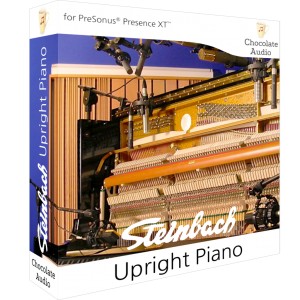
A high quality Italian-made upright piano sampled in full detail. The recording techniques used make this piano fit for many different uses, from classical to pop, country, rock and beyond.
This is a world-class piano recorded in a state-of-the-art studio with choice microphones and audiophile preamps and converters. Great attention was paid to recreate Steinbach’s signature full, organic, sound through sampling. The sample set features eight dynamic layers and a sustain pedal resonances layer, four release sample layers and pedal and key release noise effects, tuned to perfection using Presence custom scripting.
The Steinback Upright was recorded with two different phase-coherent setups: Blumlein stereo and Spaced stereo, recorded with Royer R121 matched-pair ribbon mics through Millennia preamps. Studio One Professional users can load the multi-instrument preset which combines the two microphone-sets for an even fuller control on its sound.
Last but not least:
The Chocolate Audio Pianos are compatible with Studio One 3.2 or later: Prime, Artist, and Professional editions.
All of the pianos in this family have the following onboard script controls:
- Tuning: 440/442 Hz
- Level control for Sustain Resonances, Pedal Noise and Release samples
- Velocity Curve control
- Hold, Decay, Release envelope controls
- Touch Response* control: sets the amount of pre-attack key noise heard, sets the attack time at higher settings.
New Studio One Loops from LoopMasters available at shop.presonus.com
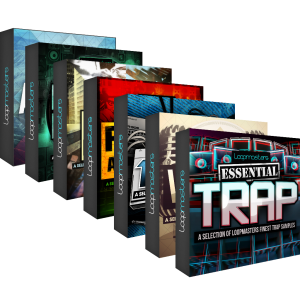 We just launched no fewer than seven new loop packs for Studio One, all from LoopMasters! These cover a lot of sonic territory including Ambient, Drum and Bass, Techno, Trap, and more.
We just launched no fewer than seven new loop packs for Studio One, all from LoopMasters! These cover a lot of sonic territory including Ambient, Drum and Bass, Techno, Trap, and more.
LoopMasters’.audioloops and .WAV files sound great, professionally produced at 24bit/44.1KHz, and are very reasonably priced. Get some inspiration for your next track for less than the cost of a lunch for two! Each of these packs contains 200 loops, (they are Loopmasters, after all) but you also get several drum kits and presets for Studio One’s Impact in every pack.
Click here to learn more about the LoopMasters sample packs—be sure to check out the audio demos to hear them for yourself!
Studio One 3.3 Available Now
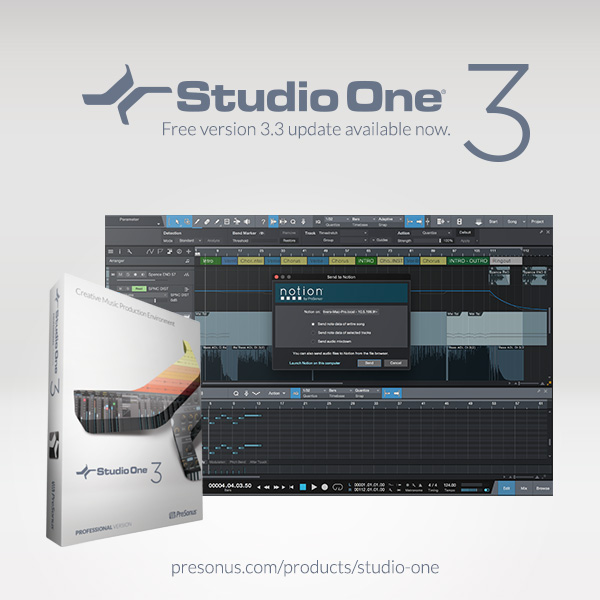 Studio One 3.3 is available now!
Studio One 3.3 is available now!
Just click “Check for updates” from the Start page in Studio One. This is a free update for all owners of Studio One 3, Artist or Professional.
Features and updates include:
- Single-click global effects on/off
- Deeper integration with Notion—compose in Studio One 3.3 and send note data to Notion 6 for editing and printing. You can also export audio to Notion 6.
- Multi-track drum editing improvements—instantly quantize using beat slicing
- Disable tracks, instruments, or plug-ins to improve CPU load and latency
- New Video Engine
- Click here to buy Studio One from shop.presonus.com
- Click here to find a dealer in the USA
- Click here to find a distributor outside the USA
Vintage Reverbs from Convology Now Available for Studio One
Convology Vintage Reverbs for Studio One
We’re proud to introduce this triple-pack of incredible vintage reverbs from Convology. These Add-ons, available at shop.presonus.com, have been meticulously modeled from many hard-to-find plate reverbs, spring reverbs, and digital reverb processors from across the globe. We can’t really overstate what an undertaking this was. The Convology Vintage Reverbs are available in a bundle pack, as well as individually.
These impulse responses work with Studio One 3 Professional’s Open AIR convolution reverb. Just download and install, and you’ll have all of the benefits of real-deal vintage ‘verb vibe… with none of the disadvantages:
- eBay expense
- Shipping damage and courier insurance claims
- Expensive replacement components
- Use of valuable studio space
- Scarce qualified repair personnel
Vintage Reverbs — Digital
This powerful collection of impulse responses brings back the sound of the early 80s reverb units. While many of today’s digital reverbs are renowned for their realistic quality, there’s an undeniable sonic mojo to some of the early digital efforts.
Full Listing of sampled reverb units
Digital Reverb 245 – (10 files) New York and Switzerland
Digital Reverb 246 – (20 files) Austria and Switzerland
Digital Reverb 248 – (16 files) Nashville, TN, and Denver, CO
Digital Reverb 250 – (26 files) Nashville, TN
Digital Reverb 245
The 245 was the 244 with the addition of pre-delay and a reflections settings. While the other German units incorporated some of these same reflection settings in algorithms, the 245 gave you the flexibility to really dial in those settings. When you look at these files, under the microscope, it’s interesting to see the early reflections (spikes) in the audio files. There was a great deal of audio engineering science that went into the reflections, how far or close together they would be, to emulate different rooms, halls, etc. The 245’s longest reverb time is around 5 seconds.
Digital Reverb 246
uses the algorithms from the 250 as does the 248, with a great deal of user control and flexibility. It also encompasses a slot for expanded memory similar to the 248. It has 6 program modes with a programmable low pass filter, reflections, and decay.
Digital Reverb 248
The 248 was the last unit made in this series and is treasured by many as being solid and quite nice sounding. The 248 was loaded with all kinds of presets and adjustable algorithms including, Baroque Church, Cathedral, Romanesque Church with numerous size rooms, halls and even stairwells, bathrooms and a preset called “Tiny Room.” The 248 is a very able processor and is used even today, like so many of these vintage units, by major recording artists around the world. One of our units was used by leading country artists such as Reba, Carrie Underwood, and Luke Bryan.
Digital Reverb 250 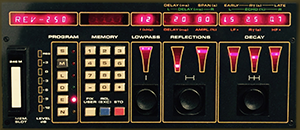
The first true DSP manufactured. The 250 uses 12-bit, 24k converters, low passed around 11Khz. This unit has large levers on top, weighs around 100 lbs and looks like it is from outer space – nicknamed the “R2D2.” No doubt, this is one of the finest DSPs from the era, with the few who own one of these remaining pieces of vintage outboard gear, still using them frequently and unabashedly. There is a 251 and 252 unit that are offshoots of this model. There were only around 250 of the original units made and then were adapted to the newer 251 interface and 252 upgrades with the 252 being a rack mounted version.
Vintage Reverbs — Plate
No two plate reverbs sound exactly alike. Even when made by the same company! Years of use, storage, re-conditioning, re-tuning, driver condition, pickups, and upgrades made to a plate unit each impart a sonic consequence. There’s a reason that some studios still reserve the space for a massive, heavy, expensive plate reverb—they tend to age like fine wines.
Full Listing of sampled reverb units
Plate Reverb Eco II (8 files) – Appleton, WI
Plate Reverb Eco III (13 files) – Sweden
Plate Reverb 140 Tube (16 files) – Nashville, TN
Plate Reverb 140 (19 files) – Finland
Plate Reverb 240 (15 files) – Los Angeles, CA
Plate Reverb Lawson (13 files) – Nashville, TN
Plate Reverb 140
For many, the 140s are viewed as king of the hill for a number of reasons. They were the first and came to market in the late 1950s. They tend to be a little warmer, tend to replicate, as they were originally designed, the sound of a concert hall and with limited EQing can for the most part, more readily replicate a dark, bright or a warm sounding room, etc. There are beautiful sounding files in every 140 model sampled—try them all along with very cool hybrid impulses that really are a solid addition to anyone’s convolution library!
Plate Reverb ECO
Tend to be brighter and a little more metallic sounding. Useful to bringing certain production elements out in the mix when you need it to cut through. These units were a little smaller than the Plate Reverb 140.
Plate Reverb 240
The 240 is darker sounding. Weighing 148 lbs, with dimensions of 1’ X 2’ X 2’. Some say better on shorter settings and for sound sources like drums. Originally designed as a way to make the original 140 (4’ X 8’) in a smaller and lighter box. It really was a technological feat for its time. They use a gold foil plate and are a hybrid between the original large 140 plate and early analog to digital rack mount and smaller floor units, although the 240 is totally analog.
Lawson
Tends to be brighter, iwth a bump in the lower mids tends to warm them up. This unit was designed and built by Gene Lawson who continues to make microphones today at his shop in Nashville, TN. His microphones are well regarded and his tenure in the business is remarkable.
Vintage Reverbs — Spring
This impressive collection of impulse responses brings back the famous sound of no fewer than 26 spring reverb units, sampled in 6 different countries including Britain, Canada, Netherlands, New Zealand, Scotland, and the USA.
Many pieces of gear included in this Add-on have been used by major recording artists, like tube springs that have been used by The Rascals, Van Morrison, and in James Brown’s famous “It’s a Man’s Man’s Man’s World.” (K-100 Spring)
General Overview
For many who grew up in the era of plates and springs, most were drawn to plates for very good reasons. After careful consideration and reaching out to studios around the globe for the most interesting vintage springs that could be found and acoustically captured, some of these springs are just absolutely gorgeous with the spring and electronics of the units, really creating some fantastic sounding reverbs–the 3D audio quality that many engineers aim to find.
If you’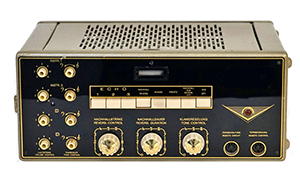 ve always fancied yourself a plate reverb individual, this library will definitely change your mind. There are springs of all kinds, and yes, there are some boingy ones—gotta have a few for that vintage guitar, lead vocal, and organ sound, right? There’s also mono and stereo versions, along with a variety of lush and warm-sounding springs that nearly sound like a plate—they deliver the “reflections from nearby walls” as only a spring can—when light tremor and flutter of the spring occurs.
ve always fancied yourself a plate reverb individual, this library will definitely change your mind. There are springs of all kinds, and yes, there are some boingy ones—gotta have a few for that vintage guitar, lead vocal, and organ sound, right? There’s also mono and stereo versions, along with a variety of lush and warm-sounding springs that nearly sound like a plate—they deliver the “reflections from nearby walls” as only a spring can—when light tremor and flutter of the spring occurs.
This spring reverb collection is complete with a wide range of springs, useful for a variety of applications. There are a good number of impulse response files in this library that you wouldn’t hesitate to apply to the lead vocal–they’re that good, and would absolutely compete with some of your favorite – digital or plate reverb presets. A number of leading engineers and producers use springs on a regular basis and some as their main “go-to” for reverb in general.
Click here to buy Vintage Reverb Collection at shop.presonus.com
